Meet the golf manager: Dean Muir
Related Articles
Dean, from The Machrie Hotel & Golf Links on the Scottish island of Islay, talks about the major changes the iconic course has gone through in the last six years, including installing its first-ever irrigation system as well as 40 bunkers.
The Machrie is a Willie Campbell designed (and redesigned by DJ Russell and reopened in 2018) iconic links stretching to over 7,000 yards that dates back to 1891, which regularly features in top 20 lists for the best golf courses in Scotland.
The terrain is set on dunelands bordering on Laggan Bay, and it offers Hebridean views of the Atlantic, the peaks of Beinn Bheigeir and the Paps of Jura. The venue is one of the main tourist attractions for the whole island of Islay.
We speak to its golf manager, Dean Muir, about the maintenance of this stunning facility.
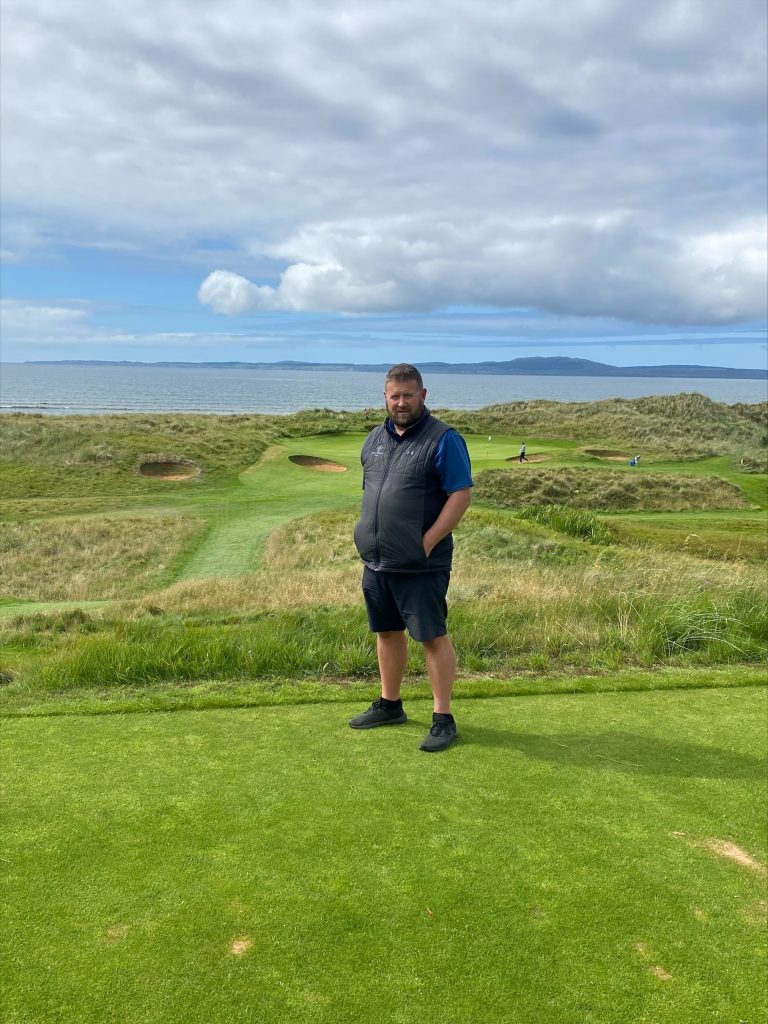
Dean Muir
Hello Dean, what was your path to greenkeeping and how long have you now been at The Machrie Links?
I began my greenkeeping career by attending Oatridge College doing a full-time course in greenkeeping. Once finished I gained employment as a member of the greenkeeping team at Gullane Golf Club. I then moved on to the Honourable Company of Edinburgh Golfers at Muirfield where I was a greenkeeper for eight years then the deputy course manager for nine years. I completed my HNC in sports turf management through Elmwood College distance learning.
I have now been employed at The Machrie Links for seven years.
Who is in your current team?
We currently have a team of eleven: Dean Muir – course manager; Iain Flanigan – deputy course manager; Graeme Hamilton – course supervisor; Dugald McKerrell – mechanic; David Brown, Allan Robertson, Matthew McMillan and Edward Ostle – greenkeepers; and Ryan O’Neill, Peter McGhie and Oscar Rodwell – seasonal greenkeepers.
We try to ensure full training is given on all tasks to all team members so everyone can do nearly everything. This ensures nothing becomes overly repetitive and avoids boredom of doing the same tasks day in day out. We also offer the option of education and training which also helps in ensuring we have a motivated and determined team that works to its full potential.
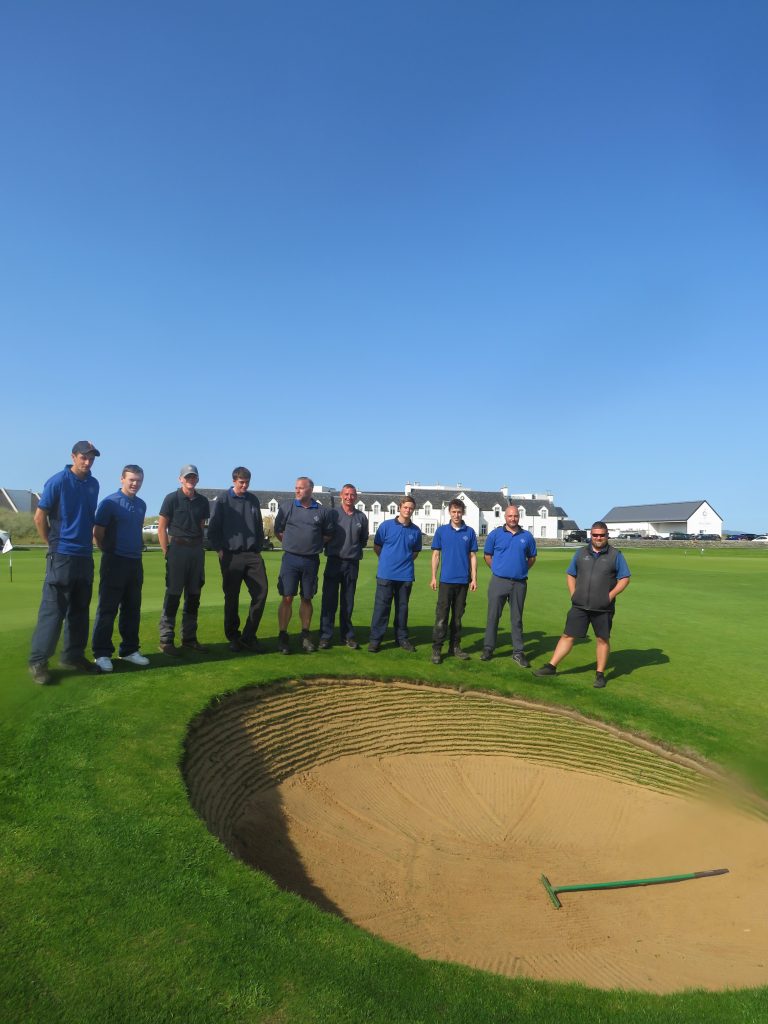
The course has undergone a significant and exciting redevelopment since 2015. Please can you explain what has been done and what effects it’s had on the management of the course?
The course underwent a major renovation between 2015 and 2017, the redesign work by course architect and former tour player DJ Russell and was implemented by Edinburgh Landscaping and the greens team. There were 15 new greens constructed on the course and 18 new sets of tees, many new or part of new fairways were built to change some of the playing lines to offer improved visuals and playability of the course. The old Machrie was famous for the amount of blind approach shots.
A major reason for many of the changes was that the old greens and fairways could sit under water for large parts of the winter and the course would become unplayable. Fortunately, we now only have a couple of areas in the dune slacks where we can retain some water, these are primarily due to the water table being raised by tidal movement in the early part of the year. As part of the renovation we tried to minimise the labour intensive areas throughout the course to enable us to be able to focus our resources on the essential areas.
A new driving range, short game facilities and Hebrides putting green which is 4000m2 were also added as was the Wee Course, which is a six-hole par three course which can be played in multiple different routes.
Traditional Scottish links tend to be flatter and more out in front of you. How would you now describe The Machrie Links?
The Machrie Links is more of a hybrid between Scottish and Irish links in style with many of the holes being played through the tall dunes, with sweeping fairway contours. There is a wonderful feeling of remoteness and isolation whilst on the course which very much adds to the charm and experience.
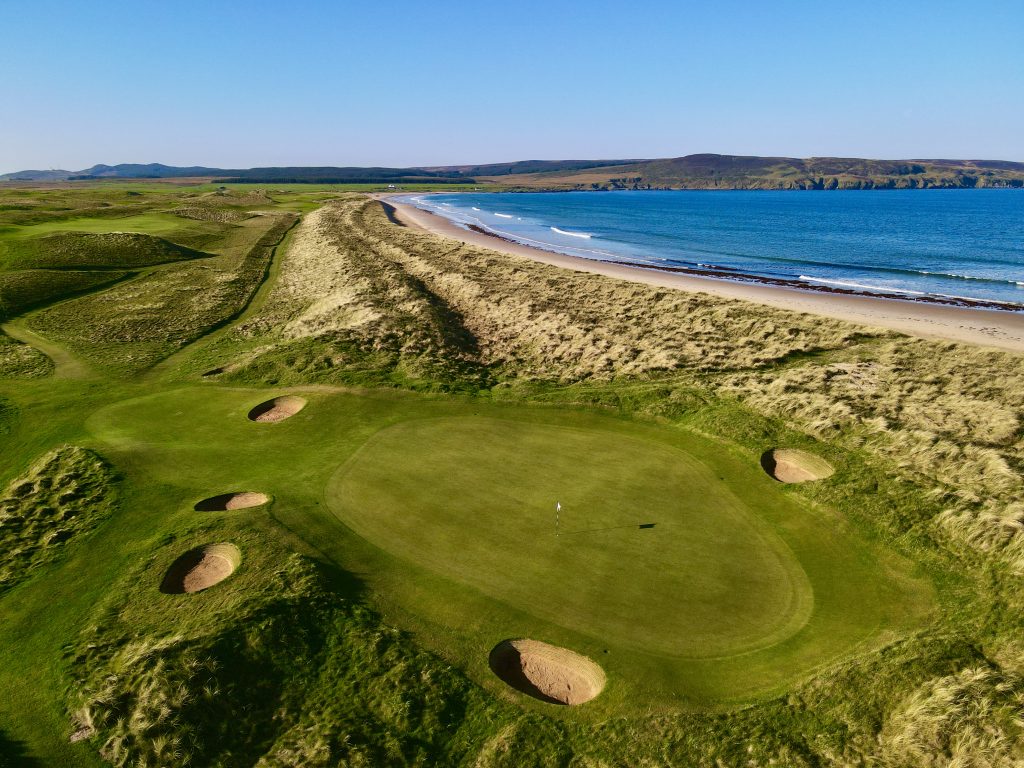
default
The course did not have an irrigation system until 2015. What system did you choose to install, where do you draw your water from, what level of improvement has it made to the management of the course and how has this elevated the overall standard of the course?
In 2015 The Machrie Links had its first ever irrigation system installed, this is a Hunter Pilot system with automatic irrigation on greens, approaches and tees. This was installed by Irrigation Control over three years as it was being completed as areas were being constructed. Without this we would have never been able to carry out the renovation of the course successfully. The system is used sparingly and only enough water is applied on the greens to keep the greens healthy, we like to promote fast firm links conditions whenever we can. We are currently planning an upgrade to the current system to give us additional coverage over certain areas.
Being located on an island presents a good number of challenges, how do you manage machinery breakdowns and maintain the fleet?
We are fortunate to have a full-time mechanic who maintains our fleet; lots of preventative maintenance goes on to ensure wherever possible we can limit the breakdowns, when we do have any issues, we are supported well by our suppliers, even if it’s just a phone call for advice. Parts can take a little longer to get to the island, so we try to be organised and ensure we have everything ordered in good time with a reasonable stock of the essential spare parts.
You are undertaking a seed exchange programme to the greens, what cultivars are you using, how often are you overseeding and how effective has the programme been to date?
On greens we overseed around six times a year, this is with Bar Fescue. Usually, three times early in the season with a mixture of pot seeding, Vredo disc seeder and Blec dimple seeder varying the rates between 20-35g/m2. We have discovered overseeding fescue late in the year, it tends not to be strong enough to survive the winter months where there can be limited sunlight and high rainfall. We then overseed Bar All Bent in June, July and August with the Blec at a rate of 6g/m2, progress can be slow but improvements in the botanical composition is definitely being made.
We also have an intensive overseeding programme on the new fairways, where we are trying to use high thatch producing fescue and bent cultivars to give us a build-up of organic matter. This is required on the pure sand fairways to enable us to retain moisture and nutrients for them to become more sustainable with less inputs.
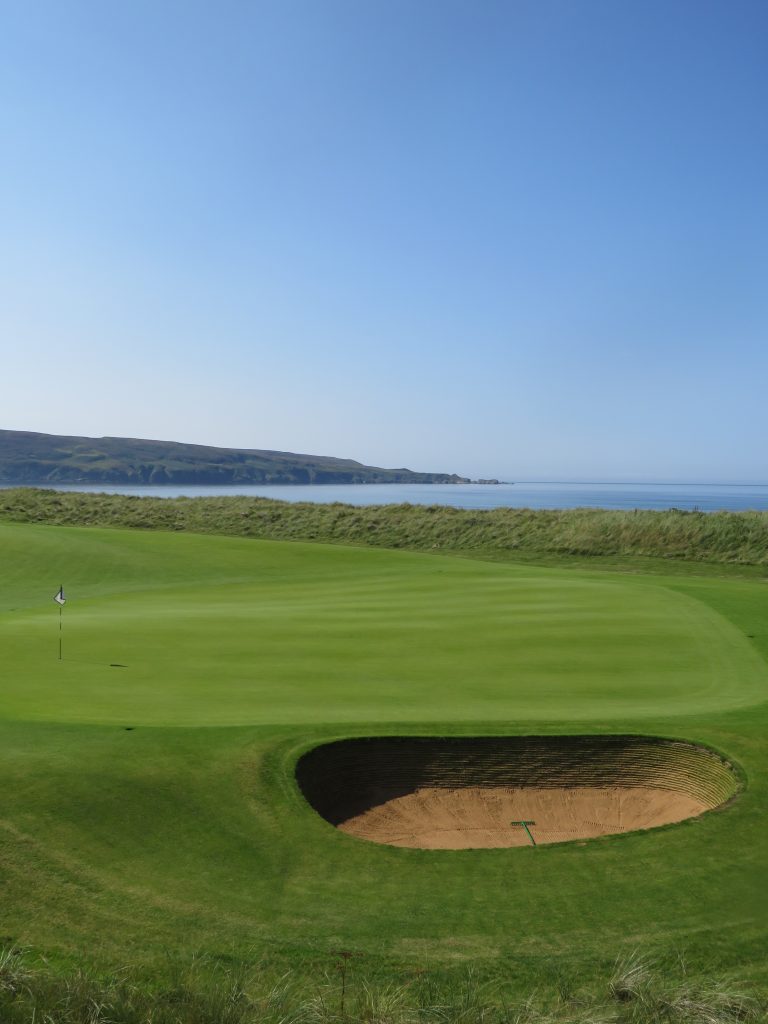
There is a significant amount of heather across the course, how are you managing this?
The heather in play areas has been regularly burnt from wildfires over recent years so it is currently a wonderful low ground cover; the colours through July and August when it blooms provides a wonderful contrast to the dunes and the cut and maintained areas. We plan to trial burning other out of play areas in time so we can determine an effective management plan for the future.
Can you outline your aeration programme?
We 8mm pencil tine greens throughout the season on a four to six week basis, this causes little disruption to the surfaces. Throughout the offseason we will run the Wiedenmann GXi8 through fairways, every second year with 19mm tines and greens and tees with 12mm tines. We will then concentrate on high wear areas such as walkways and traffic routes when required. These plans require flexibility as we are working with nature; everything is not always in our control.
How did you come to select EcoBunker as your preferred solution, what was it that impressed you most about the product and how did it make installation of the 40 bunkers possible across the course?
The decision was made to go with EcoBunker as being on an island with limited resources we would never have been able to install natural turf bunkers in these kinds of numbers without great cost year on year. In both terms of construction and ongoing labour costs. The EcoBunkers give us a one-time build which will last for many years which require very limited maintenance. As they mature and have some growth on their faces, they become much more natural in appearance which is my preferred look.
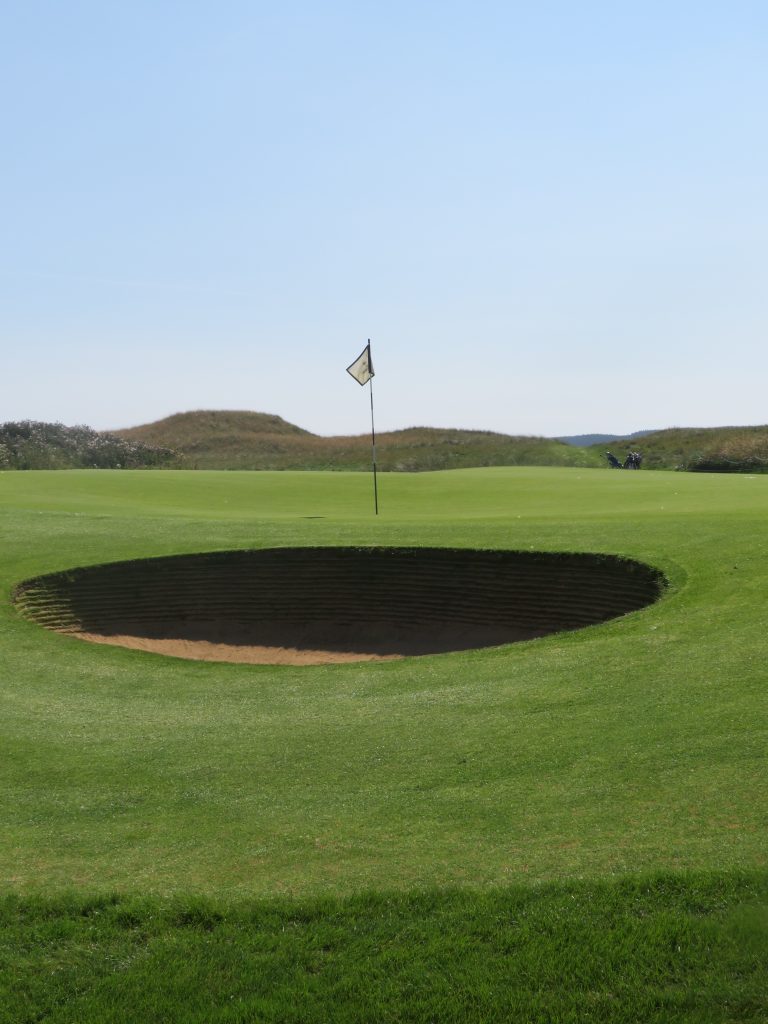
How easy was it for your team to install the EcoBunker solution and what did you do to the bunker faces to make them look even better and more natural?
With many years of experience from building revetted bunkers from my time at Muirfield I was able to lead the team in the construction. The training from the EcoBunker team was incredibly beneficial. There are some key differences in the construction from using natural turf and this allowed us to deliver a quality outcome in an efficient manner. There’s no substitute for high quality hands-on training and we would thoroughly recommend it to clubs considering the EcoBunker system.
Some of the EcoBunkers have been in situ for three years, how have they naturalised to the course and what labour saving has EcoBunker made in terms of maintenance?
We have at times brushed fescue seed into the faces to accelerate the naturalisation process. For maintenance we only need to Flymo around those bunkers in short grass whilst others only get a trim with the electric hand shears around the natural turf around the top edge. There is no fly-mowing or strimming of faces and no edging of the faces as the natural sand build up doesn’t occur.
Training and education are key to developing a good team, what do you do to ensure you are investing in raising the standard of practice and performance from greenkeeping team members and how would you describe your style of management?
Every year when the budget is built there are provisions for education and training, this has been hampered in recent years with the Covid pandemic but it’s something we will look to catch up on. We send team members to Elmwood for their Sports Turf SVQ Level 2 and 3. I am a great believer in investing in the team and developing their skills as well as knowledge.
In terms of management, I believe the biggest strength is being able to be fair but strong whilst being supportive. Empathy is essential as to get the best from people you need to support them if and when required. I believe where possible the team should come to work with a sense of enjoyment and pride in what they do. We ensure that there is a split between the perceived menial tasks such as bunker raking, divotting and flymowing and the preferred tasks such as mowing, seeding, topdressing etc.
Communication is a vital component for any team, I like to give the team a voice to allow them to make suggestions and give them ownership of tasks. As part of the team’s development, we also plan away days to other venues to see what we can learn from what other courses are doing, being on an island means this isn’t easy but a vital learning experience.
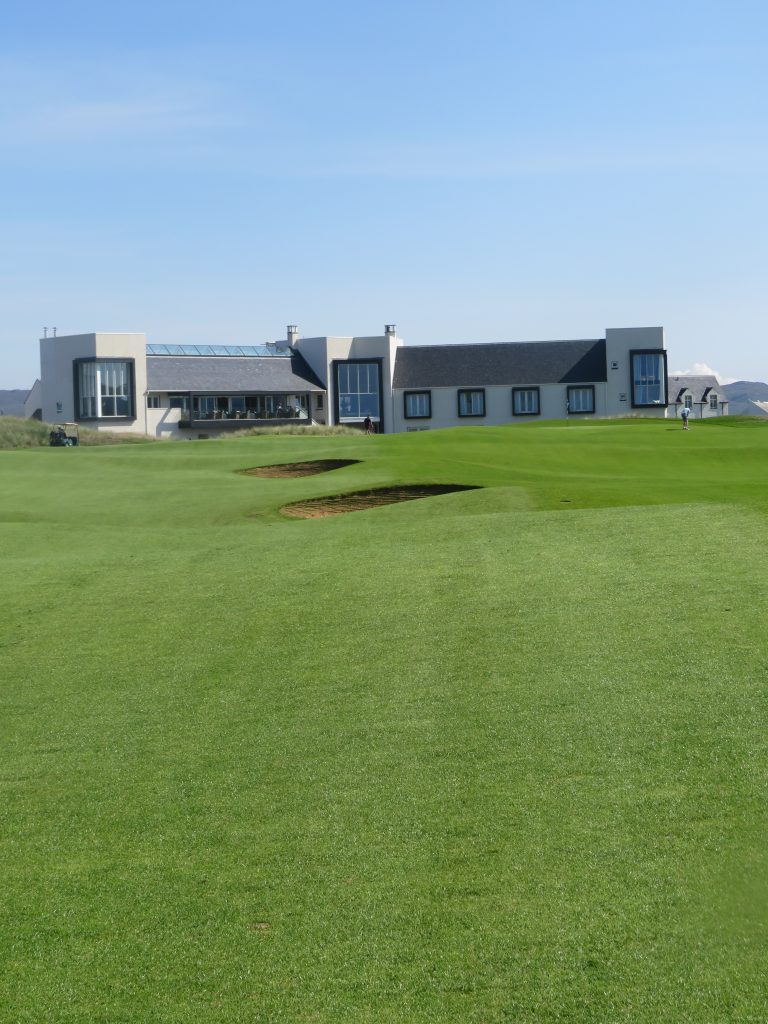
Barnacle geese continue to be a challenge to the course, is the population still continuing to grow, how much of a problem are they now and how are you dealing with this?
Barnacle and gray lag geese visit Islay in the hundreds of thousands every winter, these are still a major problem for the golf course. They roost overnight and peck the surfaces constantly whilst leaving their droppings everywhere. As they are protected there is not much we can do except try to scare them and keep them moving away from the golf course.
What machinery fleet are you currently using, are you looking to make any further additions and what piece of kit impresses you most?
We have multiples of Toro and John Deere machinery as well as Wiedenmann, Blec, Vredo, Lastec, Tru Turf and Dakota, we choose the best machine for the task irrespective of the manufacturer. Any machine needs to be able to handle the contours of the land and the harsh conditions that can be found on the edge of the Atlantic Ocean. I wouldn’t say I have a particular favourite as they are all purchased for specific tasks which they are designed for.
What height of cut do you use across the course?
Through the summer months greens are cut at 4mm, tees and surrounds at 8mm and fairways 13mm, the fairway cut is kept slightly higher this year as we have experienced a lengthy spell of drought conditions. Semi rough is 50mm and cut rough 120mm. Man hours can vary depending on various factors such as weather, growth rates, golfers and resources available to whether we triple or pedestrian mow.
The hotel was opened in 2018 following a complete renovation and expansion, what effect did that have on the level of visitors and play to the course and now that we seem to be seeing a light at the end of the tunnel to this pandemic, are you starting to see an increasing level of golf bookings from overseas visitors desiring to play the course?
The hotel has only had one full year of trading since opening due to the pandemic, which has made things difficult. Since reopening in May 2021, we have been very busy, there has most definitely been a thirst for remote travel destinations this year. Hopefully this will create disciples who will spread the word about how amazing The Machrie Links is, and our numbers will continue to grow. The feedback has been phenomenal. Many of our overseas bookings have been pushed back due to the restrictions so hopefully we will see many being able to travel in 2022.
What currently gives you the greatest satisfaction from your job?
The satisfaction of the surfaces we are providing consistently on a daily basis, considering the team which has been made up of mostly islanders who have had no experience in greenkeeping when they join us. Over the last winter season 38 EcoBunkers were built and 10 new championship tees were added which was way beyond my expectations of what was achievable, this was down to great teamwork and the desire of the team to get it done.
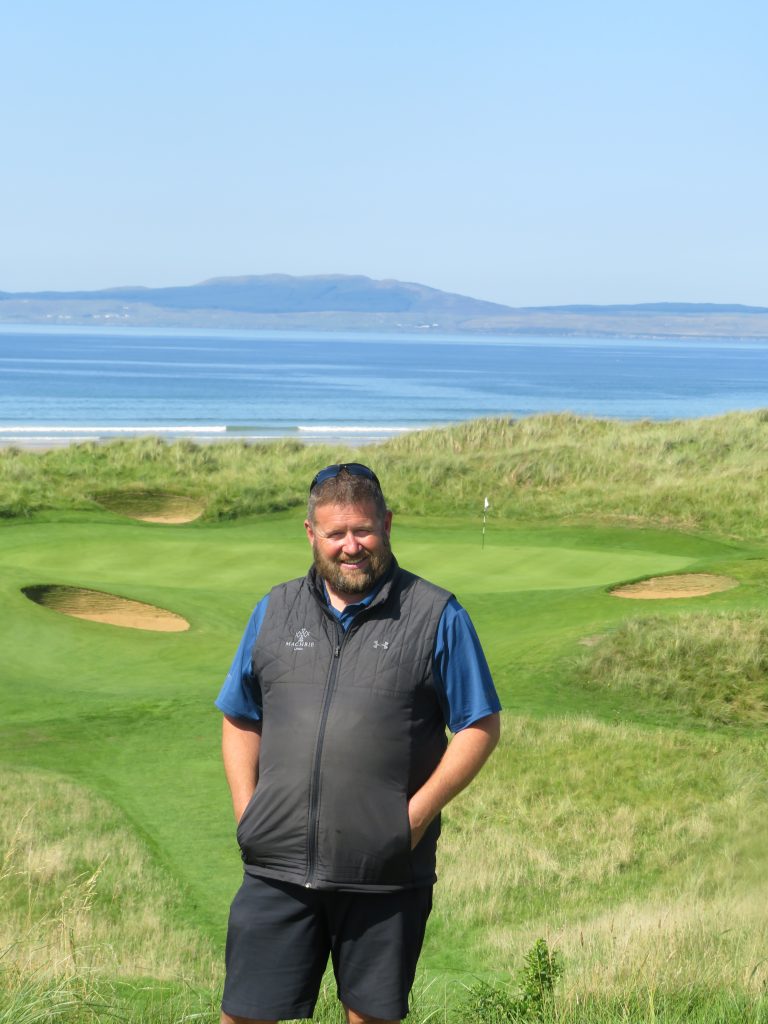
With your experience, what advice would you give to youngsters starting out and wanting to pursue a career in the profession?
Anyone looking for a career in greenkeeping should look to work hard, listen to their peers and don’t be afraid to ask questions. Learning and developing any skills comes from being interested and passionate about the job and all the tasks that that involves. Bunker raking and menial tasks are equally as important to the presentation of the course.
What changes do you think need to be made to benefit the industry sector and profession of the greenkeeper?
There have been significant strides in the industry in the professionalism and perception from others of course managers and greenkeepers. They are no longer just seen as grass cutters. Going forward there needs to be further awareness and a management of expectations for golfers regarding course maintenance. Many tools have been lost, which makes it more difficult.
Greens speeds are always a contentious point, whilst once greens running at over 10 feet on the stimp were considered fast this is no longer the case and as greens speeds have increased times for rounds have also increased, even more so of an issue with the introduction of the World Handicap System.

























